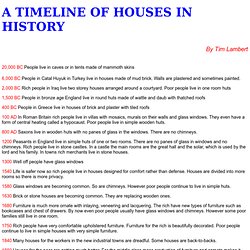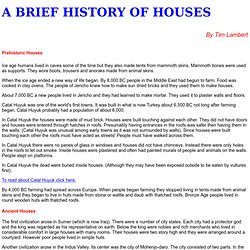

Sumerian Photos. Ancient Sumer page 1 A map showing the location of Sumer. Ur excavation from the air. Artist's painting of a Sumerian city. Another conception of a Sumerian city. The houses were constructed of dried clay bricks with woven reed roofs. A drawing of the Ziggurat at Ur. A fantasy of Lagash, a Sumerian city. Sumer page 2 Back to Homepage. Gmail. History of Houses. As of July 1, 2013 ThinkQuest has been discontinued.

We would like to thank everyone for being a part of the ThinkQuest global community: Students - For your limitless creativity and innovation, which inspires us all. Teachers - For your passion in guiding students on their quest. Partners - For your unwavering support and evangelism. Parents - For supporting the use of technology not only as an instrument of learning, but as a means of creating knowledge. We encourage everyone to continue to “Think, Create and Collaborate,” unleashing the power of technology to teach, share, and inspire.
Best wishes, The Oracle Education Foundation. Iaste.berkeley.edu/pdfs/02.2e-Spr91georgalli-sml.pdf. Home Delivery: Fabricating the Modern Dwelling.
A Timeline of Houses. 6,000 BC People in Catal Huyuk in Turkey live in houses made of mud brick.

Walls are plastered and sometimes painted. 2,000 BC Rich people in Iraq live two storey houses arranged around a courtyard. Poor people live in one room huts 1,500 BC People in bronze age England live in round huts made of wattle and daub with thatched roofs 400 BC People in Greece live in houses of brick and plaster with tiled roofs 100 AD In Roman Britain rich people live in villas with mosaics, murals on their walls and glass windows. 800 AD Saxons live in wooden huts with no panes of glass in the windows. 1200 Peasants in England live in simple huts of one or two rooms. 1300 Well off people have glass windows 1540 Life is safer now so rich people live in houses designed for comfort rather than defense. 1580 Glass windows are becoming common. 1630 Brick or stone houses are becoming common. 1680 Furniture is much more ornate with inlaying, veneering and lacquering. 1880 Houses for the poor are getting much better.
A History of Houses. In the 18th century a small minority of the population lived in luxury.

The rich built great country houses. The leading architect of the 18th century was Robert Adam (1728-1792). He created a style called neo-classical and he designed many 18th century country houses. However the poor had none of these things. Craftsmen and laborers lived in 2 or 3 rooms. In the early 19th century houses for the poor in Britain were dreadful.
The bottom room was used as a living room cum kitchen. Fortunately in the 1840s local councils passed by-laws banning cellar dwellings. In the early 19th century skilled workers usually lived in 'through houses' i.e. ones that were not joined to the backs of other houses. In the late 19th century workers houses greatly improved. A History of Toilets. After the fall of the Western Roman Empire in the 5th century AD sophisticated plumbing disappeared from Europe for centuries.

In Saxon times toilets were simply pits in the ground with wooden seats over them. (For ordinary people that remained the case for centuries afterwards). However in the Middle Ages monks built stone or wooden lavatories over rivers. At Portchester Castle in the 12th century monks built stone chutes leading to the sea. When the tide went in and out it would flush away the sewage. In castles the toilet was called a garderobe and it was simply a vertical shaft with a stone seat at the top. In the Middle Ages wealthy people might use rags to wipe their behinds. In 1596 Sir John Harrington invented a flushing lavatory with a cistern. However in 1775 Alexander Cumming was granted a patent for a flushing lavatory. Thomas Crapper did not invent the flushing toilet. However flushing toilets were a luxury at first and they did not become common till the late 19th century.